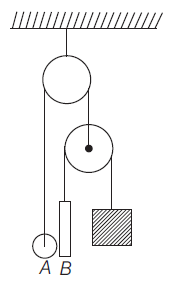Q.
In the pulley system shown n the figure, the mass of $A$ is half of that of $\operatorname{rod} B$. The rod length is $500 \,cm$. The mass of pulleys and the threads may be neglected. The mass $A$ is set at the same level as the lower end of the rod and then released. After releasing the mass $A$, it would reach the top end of the $\operatorname{rod} B$ in time (Assume, $g=10 \,m / s ^{2}$ )

TS EAMCET 2019
Solution:
